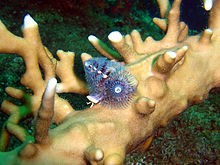Fire corals
| Fire corals | ||||||||||||
|---|---|---|---|---|---|---|---|---|---|---|---|---|

Fire corals ( Millepora sp. ) In the Red Sea , above them anthias |
||||||||||||
| Systematics | ||||||||||||
|
||||||||||||
| Scientific name of the family | ||||||||||||
| Milleporidae | ||||||||||||
| Fleming , 1828 | ||||||||||||
| Scientific name of the genus | ||||||||||||
| Millepora | ||||||||||||
| Linnaeus , 1758 |
The fire corals ( Millepora ) are a genus of sessile hydrozoa (Hydrozoa), which form an aragonitic calcareous skeleton. Millepora is the only genus in the Milleporidae family . The fire corals belong next to the hard corals (Scleractinia) to the main reef formers of the tropical coral reefs . The latter, however, belong to the flower animals (Anthozoa) within the cnidarians (Cnidaria). The oldest representatives of the genus fire corals come from the Danium (Lower Palaeogen).
They owe their name to nettle cells , which are able to penetrate human skin and then inject a very painful poison . The injuries leave scars , sometimes for life.
features

Fire corals form massive calcareous exoskeletons (= coenosteum) made of aragonite . Internally, this skeleton has a complex system of tubes. The surface is covered with a thin layer of ectoderm. The surface is covered with a multitude of microscopic pores ( mille , Latin = thousand; πόρος , gr. = Hole, pore), whereby the edges are not raised. The different species form crust-like colonies, upright plates or branch-like branches. The colonies are mostly brown or pale beige in color. The polyps sit in the pores . The polyps are polymorphic. The feeding polyps are relatively large, short and stocky. They have a wreath of four to seven short capitaten (clubbed) tentacles around the mouth. The defense polyps, on the other hand, are relatively long and slender; they have no mouth. They are randomly covered by short, capitate tentacles. Around a large feeding polyp there are five to seven smaller defense polyps, which form indistinct, rounded pore systems. The cnidome consists of stenotles and macrobasic mastigophores. There are also special polyps for reproduction that free-swimming medusas produce. The gonophores arise in chambers of the skeleton that are lined with Coenosarc. The medusas are eumedusoids with radial channels and an annular channel. The medusa has no tentacles or sense organs. The exumbrella, however, is covered with sticks of nettle cells. The sexual organs arise around an indistinct manubrium.
Fire corals live in symbiosis with zooxanthellae and get part of their food from them. In the fight with other sessile animals for light and space, fire corals are very successful and can overgrow competitors, especially gorgonians , because they grow relatively quickly.
Geographical occurrence and way of life
Fire corals occur in the Indo-Pacific , some species also in the Caribbean , mainly on the reef slopes. Despite their ability to defend themselves, fire corals are eaten by fish , bristle worms , crustaceans and snails .
Dangers to humans
The nettle poison of the fire corals causes severe itching or burning and blistering in humans . The symptoms are very similar to those after contact with nettles . Allergic reactions up to circulatory collapse are known , especially after repeated contact . In the literature, the acute treatment of the affected areas of the skin with 5% vinegar and later with anti-itchy and anti-allergic ointments is recommended.
Systematics
The family Milleporidae is placed in the Hydrozoa World Database for subordination Capitata. In the work An introduction to Hydrozoa the family Milleporidae together with the families Porpitidae, Pseudosolanderiidae, Teissieridae, Rosalindidae, Cladocorynidae, Asyncorynidae and Zancleidae are placed in a separate suborder Zancleida. The species of the genus Millepora :
- Moose antler fire coral ( Millepora alcicornis (Linnaeus, 1758))
- Millepora aspera Linnaeus, 1767
- Millepora boschmai (De Weerdt and Glynn, 1991)
- Millepora braziliensis (Verrill, 1868)
- Millepora complanata (Lamarck, 1816)
- Net fire coral ( Millepora dichotoma (Forskål, 1775))
- Millepora exaesa (Forskål, 1775)
- Millepora foveolata (Crossland, 1952)
- Millepora intricata (Edwards, 1857)
- Millepora laboreli Amaral, 2008
- Millepora latifolia (Boschma, 1948)
- Millepora murrayi (Quelch, 1884)
- Millepora nitida (Verrill, 1868)
- Plate fire coral ( Millepora platyphylla (Hemprich & Ehrenberg, 1834))
- Millepora squarrosa (Lamarck, 1816)
- Millepora striata (Duchassaing & Michelotti, 1864)
- Millepora tenella (Ortmann, 1892)
- Millepora tenera (Boschma, 1949)
swell
Individual evidence
- ↑ Michael J. Benton (Ed.): The Fossil Record 2. Chapman & Hall, London a. a., 1993 ISBN 0-412-39380-8
- ^ World Hydrozoa Database
literature
- SA Fosså, AJ Nilsen: Coral Reef Aquarium , Volume 4, Birgit Schmettkamp Verlag, Bornheim, ISBN 3-928819-05-4
- Dieter Eichler: Recognizing dangerous marine animals , blv, 2005, ISBN 3-405-16992-5
- Jean Bouillon, Cinzia Gravili, Francesc Pagès, Josep-Maria Gili and Fernando Boero: An introduction to Hydrozoa. Mémoires du Muséum national d 'Histoire naturelle, 194: 1-591, Publications Scientifiques du Muséum, Paris 2006 ISBN 978-2-85653-580-6
- Marymegan Daly, Mercer R. Brugler, Paulyn Cartwright, Allen G. Collin, Michael N. Dawson, Daphne G. Fautin, Scott C. France, Catherine S. McFadden, Dennis M. Opresko, Estefania Rodriguez, Sandra L. Romano & Joel L. Stake: The phylum Cnidaria: A review of phylogenetic patterns and diversity 300 years after Linnaeus. Zootaxa, 1668: 127-182, Wellington 2007 ISSN 1175-5326 Abstract - PDF
